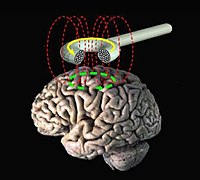
Photo from wikipedia
Background: Concerns over cognitive side effects (CSE) of electroconvulsive therapy (ECT) still limit its broader usage for treatment-resistant depression (TRD). The objectives of this study were to (1) examine the… Click to show full abstract
Background: Concerns over cognitive side effects (CSE) of electroconvulsive therapy (ECT) still limit its broader usage for treatment-resistant depression (TRD). The objectives of this study were to (1) examine the CSE of Low Amplitude Seizure Therapy (LAP-ST) at 0.5 A compared to Ultra-brief Right Unilateral (UB-RUL) ECT using Time to Reorientation (TRO) as the main acute primary outcome, and (2) to compare effects on depressive symptoms between the two treatment groups. Methods: Participants were referred for ECT, consented for the study, and were randomized to a course of LAP-ST or standard UB-RUL ECT. TRO and depression were measured by the Montgomery-Åsberg Depression Rating Scale (MADRS). Results: Eleven patients consented. Of these, eight with a current major depressive episode (MDE) of unipolar or bipolar disorders were randomized. TRO was faster for the LAP-ST (mean = 6.8 min; SE = 4.9) than standard RUL ECT (mean = 15.5 min; SE = 6.5). Depression improved similarly in the two arms of the study from baseline (MADRS: LAP-ST = 41.0; SE = 2.0, RUL = 39.0; SE = 3.8) to endpoint (MADRS score: LAP-ST = 8.0; SE7.2, RUL = 9.5; SE = 3.8). Conclusions: This pilot, randomized and blinded clinical trial, suggests that the LAP-ST (at 0.5 A) has faster reorientation and possibly lower CSE compared to standard RUL-UB ECT. Caution is advised in interpreting these results due to the small sample size of this pilot study. Thus, future studies with similar design are warranted for replicating these findings.
Journal Title: Brain Sciences
Year Published: 2020
Link to full text (if available)
Share on Social Media: Sign Up to like & get
recommendations!